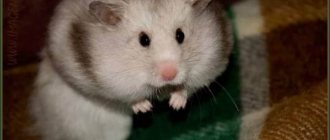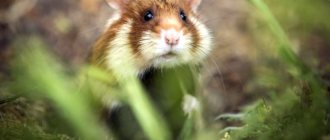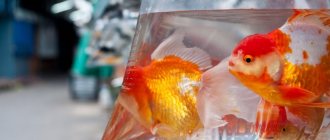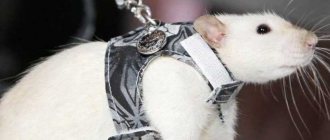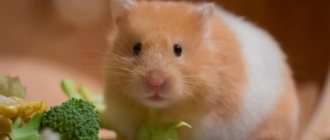- home
- General information
14.07.2018
Many people like a cute hamster with full cheeks. They are like pockets for animals to collect, briefly store and move food to a protected place. In the wild, rodents have to find their own food. For the winter, the hamster stuffs its cheeks, hibernates, periodically waking up to have a snack to saturate the body. In the summer you have to prepare a lot of food, filling your storage completely, so that you don’t have to go hungry in the winter.
The cheeks of a rodent can hold a volume of food equal to the weight of the animal. A hamster with full cheeks and pockets full will return home to fill the pantry. In order not to accidentally swallow the good he finds, he blows the grain out of his cheeks without hindrance. After emptying the pockets, the cheeks become normal size. He does this until the storage is completely filled with food. A pet can stuff its cheeks with so much food that it doesn’t fit in the pantry right away. Then it deposits part of the food on the ground, and takes the rest into the depths, after which it returns for the food left behind.
It is interesting that when collecting food of animal and plant origin, the rodent separates it: it puts grains in one pocket, and worms and grasshoppers in the other.
Pet Physiology
A hamster with big cheeks is a funny sight, but this part of the face is not initially puffy, but becomes so when there is food in it.
Read also: Dimensions and scales of photos on Instagram
From an anatomical point of view, the cheek pouches are a muscular cavity located on both sides of the head and neck and extending down to the shoulder area. A hamster with cheeks can open them - mainly from the inner shell, less often - from the outer shell. For a rodent with thick folds above the cheek, they serve as storage and transportation of food for further consumption. When you need to hide food, the hamster hides food behind its cheeks, the bags swell and easily contain a considerable supply. Similar muscular adaptations also exist in rodents such as marmots and chipmunks.
As one interesting experiment showed, the fluffy stuffs 20 almonds and a few more candied fruits into his mouth and holds it behind his cheek. The animals got their English name hamster from the German verb, translated meaning “to store.” Such thoughtfulness is characteristic not only of wild representatives, but also of domestic ones, who are always provided with provisions. There is no escape from instincts! Individuals living in the wild, stocking up for the winter, will stuff their cheeks as long as there is still room there. And observations by scientists show that the bags can hold an amount equal to half the weight of this rodent (usually about 100 g), and in special cases the mass stored even exceeds the weight of the animal!
Causes of inflammatory diseases
Hamsters use their cheek muscle cavities to ensure their normal functioning. Since they can obtain food only during the warm period of the year, the animals need to take care of significant supplies for the winter in advance. For this purpose, rodents use their cheek pouches, carrying grains and seeds into their bins. Animals in natural conditions will not put any other objects into their bags. Therefore, inflammation of the cheek pouches in wild hamsters almost never develops. At home, the animal is not threatened by predators, but sometimes close contact with a person is worse than a collision with a hungry animal.
The most common causes of inflammation are:
- The presence of sticky substances and sweets in the rodent’s diet. If the bags, which contained even a small amount of food, stick together, suppuration will certainly begin. Therefore, you need to make sure that chocolate, honey, sweets and other products that are undesirable for the animal to eat do not get into the hamster’s mouth. Human treats do not bring any benefit to rodents; for them, what is tasty is grain; the desire to feed a hamster chocolate is a common manifestation of selfishness.
- Having access to sharp objects. Even sharp sawdust can cause harm if the hamster manages to stuff it into its pouch. Sharp plastic and metal are even more dangerous. The damaged surface of the muscle cavities easily becomes infected.
- Consumption of large-fraction roughage. Too large particles of food also often provoke inflammatory processes and, in advanced cases, lead to loss of bags.
What problems may arise
The most common problems hamsters experience are:
- injuries;
- inflammation;
- infection;
- dropping out;
- food getting stuck.
Injury often occurs as a result of attempts to hide sharp objects or toys in the cheek space. A hamster may decide to stockpile not only food, but also items that are potentially dangerous to it. For example, a bolt or a piece of plastic. As a result, the mucous membranes will be damaged, which will provoke inflammation and infection.
Inflammation of the cheek pouches
A hamster that hides food behind its cheeks risks damaging its mucous membranes. If this happens, the latter become inflamed. The animal is not able to independently analyze its condition and cannot get rid of supplies in time and take a break, so it continues to injure its cheeks.
As a result, infection may occur. To prevent this, it is necessary to clean the tissues with a solution of furatsilin or chamomile decoction. This needs to be done by a veterinarian or an owner with experience, otherwise there is a risk of worsening the situation.
While stuffing the hamster's cheeks, it can damage soft tissue.
The appearance of abscesses
In the absence of timely treatment and tissue infection, an abscess occurs. The cavity fills with pus. The swelling is no longer due to food, but due to pathological contents.
The danger of the disease lies in the fact that the owner cannot detect the threat in a timely manner. The owner of the animal thinks that the hamster's cheeks are full of food.
An abscess can be distinguished from normal by elevated temperature, especially in the area of inflammation. The pet becomes lethargic, often rubs its cheeks, and spends more time in hiding.
Bags falling out
Occurs when a pet tries to place an object or large particles of food into the cavity. The disease is almost invisible visually.
The owner discovers a piece of food protruding from the rodent's mouth. Sometimes owners try to remove the problematic item themselves. This should not be done, as it can injure the hamster. Removing particles will not help straighten your cheeks.
If the bags fall out, you need to contact a veterinarian. He will clean the cavity, treat it with an antiseptic and painkillers, then set the organ back.
You cannot delay in providing assistance, as severe purulent inflammation may occur. In this case, you have to remove the bags. This does not affect the pet’s quality of life, but if the infection is severe, the rodent may die.
If your hamster's sacs fall out, you should contact your veterinarian.
Food getting stuck in bags
Owners sometimes give pets food that their pet’s body is not adapted to eat. For example, chocolate. If the hamster tries to hide it behind his cheeks, the treat will melt and remain in the cavity. It won't be possible to remove it. This will cause inflammation if the owner does not promptly clear the cavity of its contents.
The situation is worse with sharp objects. For example, small bones. The pet manages to place them in the cheek space, but he cannot get them out later. Objects scratch the mucous membranes and cause severe inflammation, which is often accompanied by infection and the development of an abscess.
When food gets stuck in the cheek pouches, an abscess can develop.
What to do if the cheek pouches are inflamed
For a domestic individual, freeing the cheeks from food can be problematic due to the fact that its muscles are less developed than those of its wild relative. If the owner is observant, he will immediately notice that the rodent, in attempts to remove food from its mouth, rubs its cheeks with its paws. It also happens that food remains in the cheek pouches in small quantities and begins to rot. As a result, the pet loses its appetite, becomes lethargic and spends more time in the house, often keeping its mouth slightly open.
Having noticed symptoms of inflammation, you should act according to the following algorithm:
- Prepare several ear sticks soaked in Furacilin solution (1 tablet per 100 ml of water) or chamomile decoction.
- Wear gloves. Secure the pet and, carefully opening its oral cavity, clean out any remaining food from the cheek cavities.
- Wash the tissues with an antiseptic (options are indicated in the first paragraph).
- If there are purulent wounds, then until they are completely healed, treatment with Levomekol should be carried out daily.
- While the treatment process is ongoing, give your pet only well-chopped food and always a sufficient amount of clean water.
Of course, if you do not have experience in such matters, then it is better to immediately contact a veterinarian. It often happens that as a result of the inflammatory process, the cheek pouch falls out. It looks as if the hamster has a foreign body in its mouth. In this case, you will not be able to cope with the pathology on your own. The bag will have to be removed surgically.
A hamster stuffs its cheeks because it is in its nature. It stores food in case you forget about it and don’t add food on time. The owner’s task is to carefully monitor the health of his pet and ensure his safe pastime.
Measures to eliminate inflammation
Fortunately, bag loss does not happen very often. But inflammation often develops with insufficient care for the animal. The owner himself can provide first aid to the fluffy. You can recognize a problem by the following signs:
- an animal's mouth is slightly open;
- apathy and lethargy;
- During palpation, compacted areas are felt.
Article on the topic: Where do hamsters live in the wild: habitat and enemies of the rodent
If the above symptoms are noted, you should not hesitate; you need to take measures to eliminate the problem. To do this, you need to rinse the cavity to reduce inflammation of the hamster's cheek pouch. All accumulations from the cavity are removed, then weak disinfectant solutions are poured into it.
You can use a regular chamomile decoction, you can dilute an antibiotic in novocaine, or use dioxidin. To administer the disinfectant liquid, use a small bulb or syringe without a needle. You can put a tube from a blood transfusion system on the syringe.
Important! During rinsing, you need to hold the animal with its head slightly downward so that the liquid does not enter the respiratory tract, but flows freely from the mouth.
The treatment for the abscess depends on the stage of development of the disease. If the abscess is just forming, then treat it with hydrogen peroxide and make an application of Vishnevsky ointment. If the abscess has ruptured, you will need an antibiotic ointment, for example, levomekol. It is used until the animal recovers. While treatment is ongoing, you need to feed the hamster in such a way as not to provoke mechanical irritation of the affected area, so give food only in pureed form.
Hamster general meaning
Small rodents with a dense build and short legs live in Asia, Central Europe, and are found in Siberia, Korea, China, Iran and Syria. Animals live in steppes, deserts, and settle in fields and gardens. Hamsters are known for their habits of storing huge amounts of food for the winter; sometimes the weight of seeds hidden in burrows reaches 90 kg.
Read also: Hashtags on the topic MANICURE
Rodents are unusually fertile, females give birth several times a year, and each litter contains from 1 to 18 cubs. The babies grow extremely quickly; after 2 months they are ready to reproduce. The ability to reproduce abundantly helps hamsters not to disappear as a species - young animals are hunted by numerous predators, for whom inexperienced cubs are very attractive prey. On the ground, rodents are destroyed by badgers, foxes and stoats, and from the sky they are snatched by crows, rooks, kestrels, and kites.
Purpose
The cheeky hamster looks funny and amusing. Cheek pouches are like pockets for rodents; their purpose is to collect, temporarily store and transport food. In nature, wild hamsters obtain their own food. It is known that during the winter they hibernate, from which they periodically wake up to saturate their body. Over the summer, they need to fill their pantries so that there are enough supplies for the entire cold period. A hamster's cheeks can hold an amount of food equal to the animal's total weight. The hamster with his cheeks stuffed returns to his hole to leave the collected supplies in it. To do this, he blows with all his might, and the grain flies out on its own. A hamster with big cheeks becomes an ordinary animal. He performs such manipulations until his pantries are full to the top. Sometimes a hamster’s mouth can be filled with grain, peas or other foods to such an extent that it does not fit into the hole; in this case, the animal leaves some of the food on the surface of the earth, and takes the rest deeper, then returns for the rest of the goodness.
Features of behavior
A domestic rodent with thick cheeks often amuses its owner. Why does a pet stuff its mouth with food, because it doesn’t need it? It turns out that it’s all about natural instinct, which is not easy to cope with. Well-fed domestic hamsters still strive to hide some of the food, and when the cage is large and equipped with labyrinths, the cheeky hamster transports food in this way from one place to another.
In some cases, the owner is to blame for the pet’s efforts to hide an extra piece. The fact is that the baby should always have a small amount of food in the feeder, because it is impossible to predict how much he will be able to eat at one time to completely saturate the body. Having experienced hunger, the pet immediately begins to make supplies for emergencies.
Bubble Eye
Bubble eyes "water eyes" are one of the artificially cultivated breeds of aquarium "goldfish". He has large eyes and ocular vesicles filled with fluid. They hang down on both sides of the head, which is why many people call them cheeks. Sometimes the bubbles reach the size of up to a quarter of the fish’s body. Because of this unusual structure, the eyes often suffer, they are easily damaged, often they simply fall off, but are capable of regeneration within three to four weeks.
6 funny animals with big lips >>>
How a hamster hides food behind its cheeks
The rodent picks up food with its paws and puts it in its mouth. First, he stuffs one muscle bag, which opens from the inside and stretches under the pressure of food, then he does the same with the second. Immediately after performing these manipulations, the animal, waddling, follows to a secluded place where it leaves the food it has stored. To free the muscle cavities from supplies, the hamster presses on its chubby cheeks with its paws. As a result, the food spills out and the tissue returns to its original state. After this, the animal goes for a new portion of food.
Read also: What to give a friend for her 45th, 50th birthday
Winter supplies
Rodents living in the wild regularly stockpile food. The cheek pouches of hamsters are quite large and as long as something fits there, the hamster will stuff its cheeks. The bags are designed in such a way that an amount of food equal to half the weight of the animal is placed there .
After the food is in the cheek pouches, the hamster with its cheeks full goes into the hole and hides supplies there. He runs very funny with his cheeks puffed out and pushes food out: he presses on his cheek pouches and blows hard. Under pressure, food flies out of the mouth, and the cheeky hamster turns into an ordinary rodent. Now the cheek pouches are empty and the animal can go for new supplies, which it does.
Now you know why a hamster has big cheeks: he stores up for the winter and survives it without problems - he ate, slept, walked and ate again. “In the wild,” rodents store seeds and grains, but they don’t disdain roots.
This is interesting: a hamster with cheeks stores up to 90 grams of food at a time! If you are the owner of this cute animal, watch how the hamster stuffs its cheeks.
Tumors
Cheek pouch tumors are another common problem in pet hamsters. The tumors are usually malignant and usually affect only one of the sacs. They can penetrate the entire tissue of the cheek pouch, which extends to the shoulders.
Packed tumors are usually hard and do not feel like a bag filled with food. These tumors (usually squamous cell carcinoma) worsen the prognosis for the hamster and are difficult, if not impossible, to remove completely while still allowing the hamster to eat normally.
Abscess in a hamster
An abscess is an inflammation after which a purulent cavity appears. It is characterized by painful sensations, decreased appetite in the animal, discharge and redness.
Causes
- a bite received from another hamster;
- impact or scratches from improperly selected bedding;
- a hamster can get injured on low-quality toys or on a cage, which in turn will lead to the development of an abscess.
How to treat?
If you managed to notice an abscess in the early stages, when it has not yet matured and looks like a small swelling, then treatment may simply consist of taking antibiotics, which are prescribed exclusively by a veterinarian. If a purulent cavity has already formed, then treatment will not be possible without surgical procedures. In some cases, you can get by by rinsing the cavity with a special solution, but in some cases, installing drainage is required.
Make sure that the abscess is not advanced. Since hamsters are small in size, even a small accumulation of pus leads to intoxication of the body.
Important! If you do not attach importance to the abscess and do not treat it properly, the disease becomes chronic. A wound forms at the site of the abscess, which takes a very long time to heal.
How to prevent it?
- If you notice a small scratch on your pet's body, give him the opportunity to take care of himself. Hamsters themselves lick and clean small wounds.
- If you treat wounds yourself, you should limit your hamster's movements. Before the procedure, wrap your pet in a scarf or small towel, as during illness they become restless and may bite or injure themselves further.
- Treat wounds and scratches with an antiseptic, and then apply an ointment that your veterinarian will recommend. Flushing will help prevent the development of an abscess.
There are various reasons
British cat
The round, well-developed cheeks of a British cat are one of the main distinguishing features of the breed. It’s not surprising that every owner of a “British dog” dreams of his pet having wow cheeks! There is an opinion among people that you can “eat” your cheeks - you just need to know what, even all sorts of recipes are offered.
But the presence or absence of expressive cheeks is purely genetic, like tail length or coat texture. That’s how nature decreed it – you either have cheeks or you don’t. There are no special diets that would help enlarge the cheeks. As in the fairy tale about Cinderella: “No connections will help you make your legs small, your soul big, and your heart fair.”
